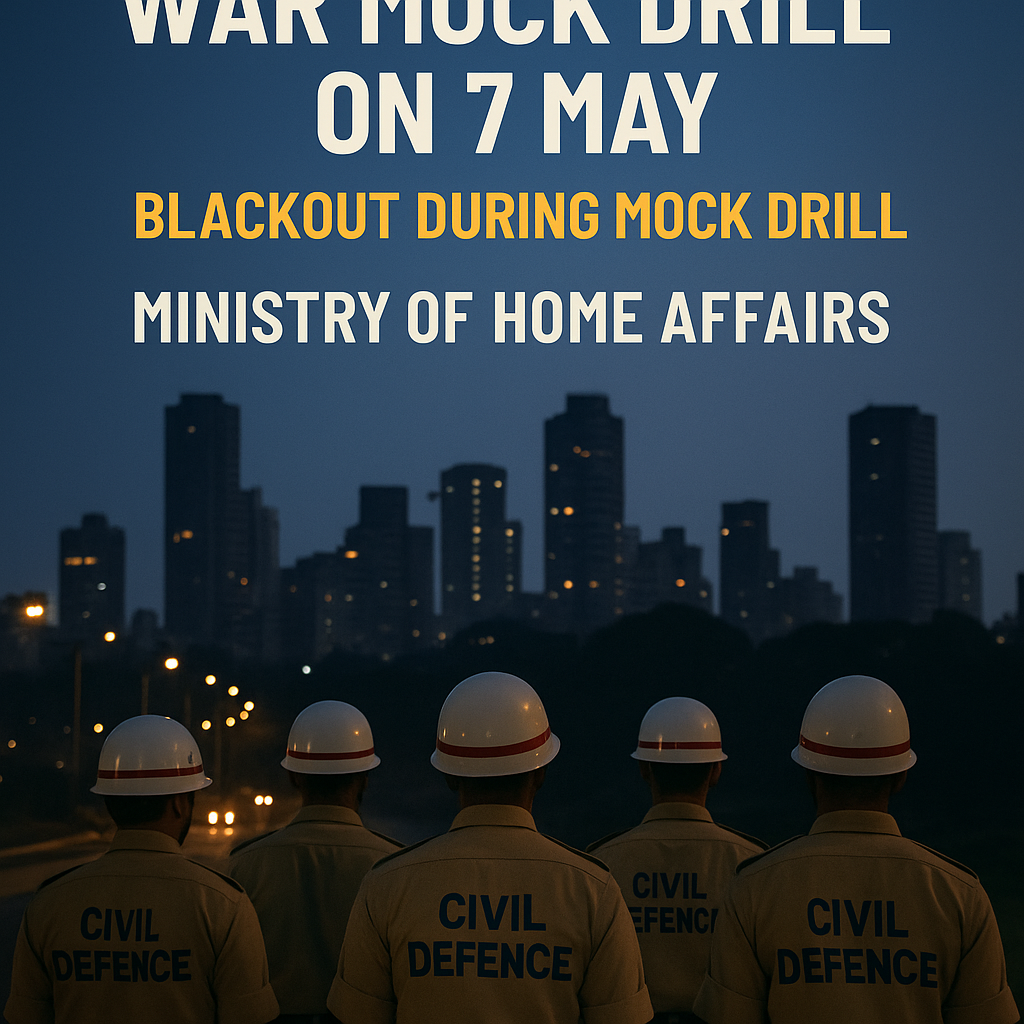Introduction: Understanding the Mock Drill in India on 7 May
India’s 7 May mock drill has sparked nationwide attention, trending in the news under keywords like war mock drill, MHA blackout, and India-Pakistan war scenarios. Organized by the Ministry of Home Affairs (MHA), this mockdrill war exercise aims to test the readiness of civil defence districts across the country. Whether you're concerned about national security, emergency response protocols, or just curious about what a war drill entails, this article gives you all the insights you need.
In this post, you'll learn:
What the 7 May mock drill is and why it's important
The role of 244 civil defence districts across India
How India Pakistan war tensions influence such drills
What the blackout drill means for civilians
FAQs and tips on what to do during a mock drill
Let’s dive into the details and uncover the real purpose behind this high-alert simulation.
What Is a Mock Drill and Why Is It Conducted in India?
Definition and Purpose
A mock drill is a simulated emergency response exercise. In India, these drills are carried out by agencies like the Ministry of Home Affairs (MHA) and Civil Defence to prepare for real-life situations such as:
Wartime emergencies
Natural disasters
Terror attacks
Infrastructure failures (e.g., blackouts)
Connection with India-Pakistan War Preparedness
Given the historic and ongoing India Pakistan tensions, such war drills are not just hypothetical. They act as preventive measures, ensuring that civil defence units and emergency services are fully prepared for worst-case scenarios.
Inside the 7 May Mock Drill: What Happened and Why
National Scale Simulation
The 7th May mock drill involved coordinated efforts from:
244 Civil Defence Districts
Home Guards
Local authorities and emergency responders
This mockdrill war simulation included:
Blackout drills in urban areas
Simulated air raids and sirens
Evacuation tests
Communication shutdown simulations
Blackout Drill Explained
The blackout component of the drill mimicked wartime conditions where cities are required to turn off lights and limit visibility to avoid being targeted. Citizens were asked to:
Turn off unnecessary lights
Avoid stepping out unless necessary
Stay informed via official government channels
The Role of the Ministry of Home Affairs (MHA) and Civil Defence
Why MHA Is Leading These Drills
The Ministry of Home Affairs (MHA) is the nodal body responsible for internal security. Organizing a mock drill of this scale is part of their mandate to ensure all civil defence districts are ready to act swiftly and efficiently in crises.
Civil Defence Districts: Backbone of Preparedness
India has designated 244 civil defence districts, each equipped with volunteers, communication systems, and logistical support. These districts participated actively in the 7th May mock drill, which is being seen as one of the largest coordinated efforts in recent times.
How Citizens Were Informed and Involved
Public Awareness Measures
To prevent panic, MHA coordinated with local media to circulate the mock drill news in advance. Informational posters, mobile alerts, and social media advisories were issued using hashtags like:
#7thMayMockDrill
#IndiaWarDrill
#CivilDefenceAlert
Citizen Participation
In many locations, civilians were part of evacuation simulations or were asked to respond to warning sirens. These real-time tests help both the government and the public prepare mentally and logistically.
Frequently Asked Questions About India’s Mock Drills
Is India preparing for a real war with Pakistan?
Not necessarily. While drills often simulate an India Pakistan war scenario, they are standard preparedness exercises. However, rising tensions may increase their frequency and intensity.
What should I do during a blackout drill?
Keep emergency supplies ready
Follow official instructions
Avoid spreading misinformation
Stay indoors unless directed otherwise
How often are such mock drills conducted?
Mock drills, including war drills, are conducted multiple times a year, but nationwide drills like the one on 7 May are rare and signal high-level preparedness.
Impact and Importance: Why You Should Care
Preparedness Saves Lives
Mock drills can significantly reduce casualties during real emergencies. They reveal weak points in infrastructure, communication gaps, and coordination issues, all of which are critical in a real India war scenario.
Public Trust and Awareness
With transparent communication, these drills build trust between citizens and the government. Involving the public ensures quicker, more effective responses.
Conclusion: Stay Informed, Stay Prepared
The 7 May mock drill was more than just a routine exercise—it was a wake-up call highlighting the need for national readiness in the face of rising global and regional uncertainties. With the Ministry of Home Affairs and civil defence districts at the forefront, India is ramping up efforts to be prepared for every possibility, including a potential India Pakistan conflict.
Whether it's a war mock drill, a blackout, or a local emergency, awareness is your best defence. Stay connected with official updates, understand the purpose of these drills, and help spread accurate information.
Have you ever participated in a mock drill? Share your experience in the comments below or share this article to help raise awareness.
Leave a comment
Your email address will not be published. Required fields are marked *




